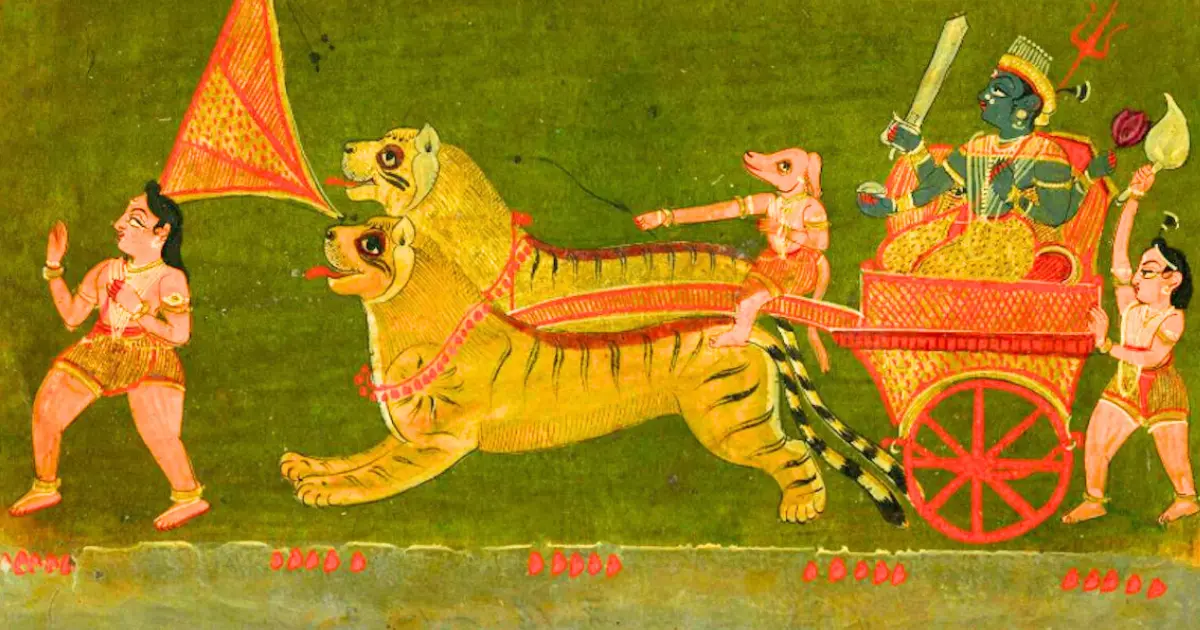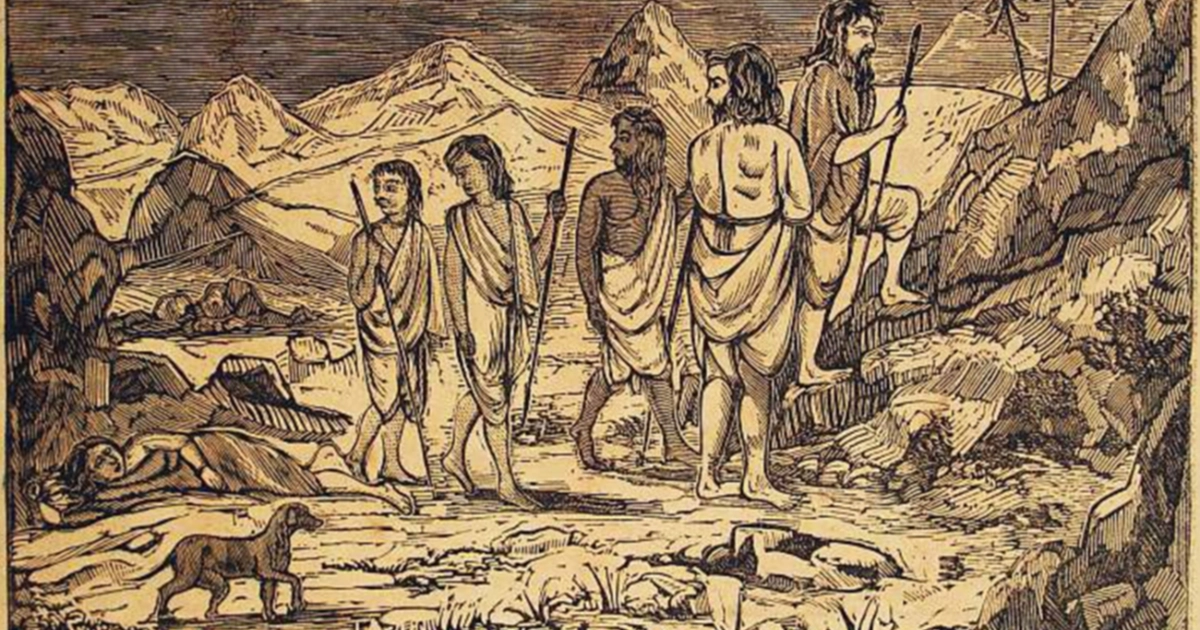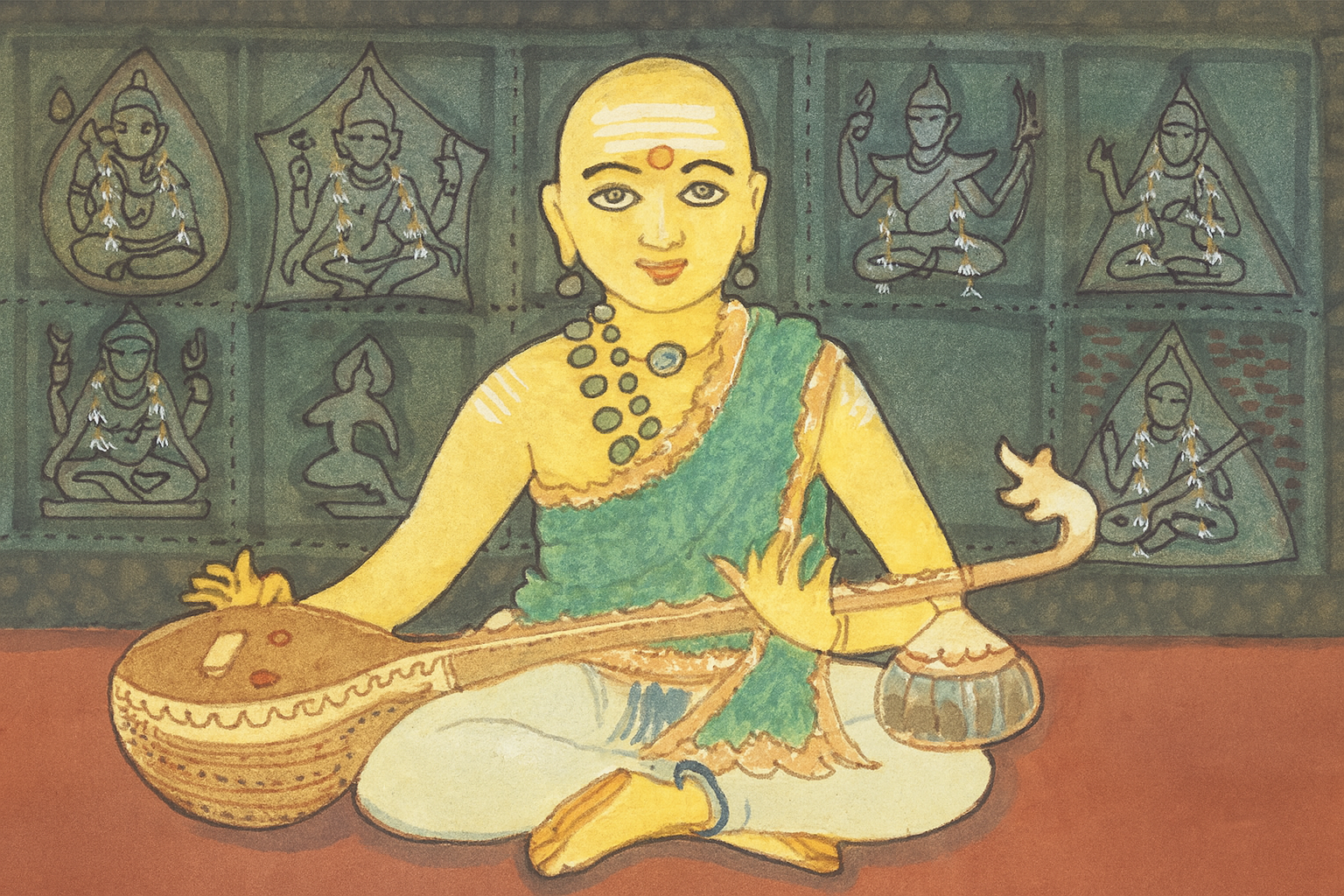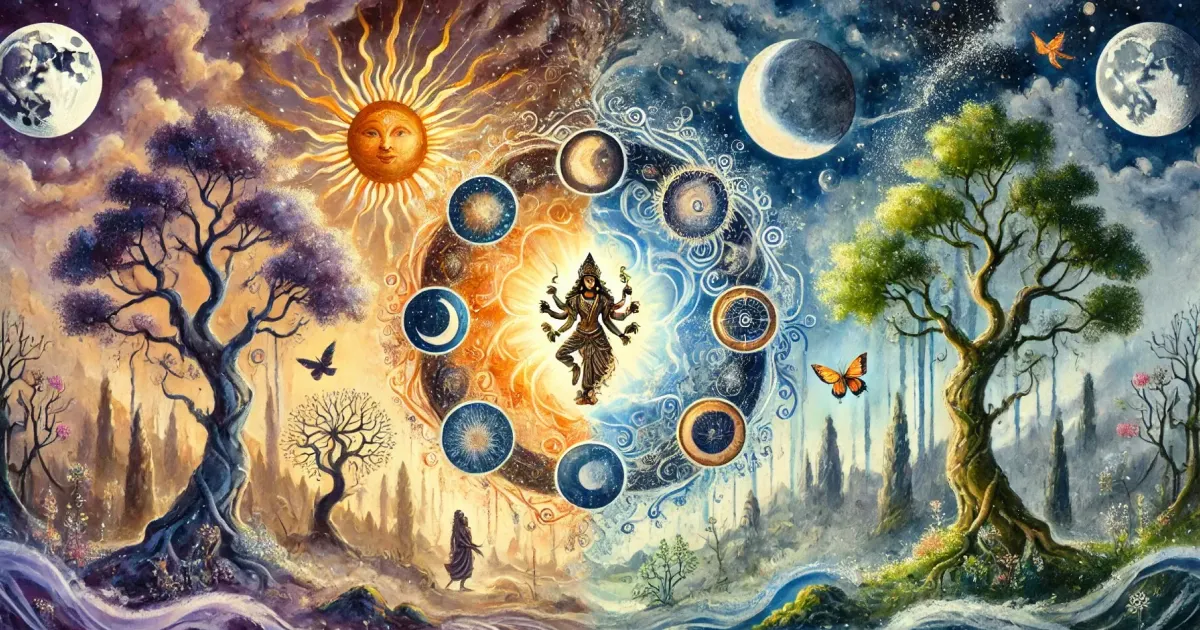praṇamya sirasā devam gaurīputraṁ vināyakam bhaktāvāsam smarennityam ayuḥkāmārthasiddhaye
(Salutations to) the god Vināyaka, who is to be worshiped with head bowed, the son of Gauri, the refuge of His devotees, for the complete attainment of longevity and good health, desires, and wealth.
Nārada Purāṇa
Gaṇeśa has come to be called Lord of the heavenly hosts or gaṇas, the wisest of the wise, Lord of the treasure of treasuries, Supreme among those who pray, King of kings. He is invoked by nearly all Hindus at the beginning of any religious ceremony and on special occasions. Vighneśvara presides over obstacles, tasked with both hindering and facilitating acts of virtue — having been willed by Śiva, who advised him to hinder the asuras from acquiring boons by performing sacrifices and other virtuous acts, and also to render assistance to the devas by removing the obstacles for performing good deeds.
Vighneśvara is known by many names such as Gaṇapati, Ekadanta, Heramba, Lambodara, Sūrpakarṇa, Gajānana and Guhāgraja. The Amarakośa lists a few of his epithets —
vināyako vighnarājo dvaimātura-gaṇādhipaḥ | apyekadanto heraṃbo laṃbodaragajānanaḥ ||
Iconography of Gaṇeśa
Through his multitude of epithets, he is variously equated with Indra and Agni. As a consequence of this identification with Vedic gods, Gaṇeśa was endowed with their familiar attributes, in visualization and art. Through the goad, the thunderbolt, and the lotus he rivals Indra; through the tiger-skin garment, the crescent moon emblem, and the snake as sacred thread he rivals Rudra/Śiva; through the noose he rivals Varuṇa; and through the axe he rivals Brahmaṇaspati. As buddhidāta he is endowed with the intelligence of Brahmaṇaspati, and as siddhidāta with the bountiful nature of Indra. Due to his popularity as the ‘Remover of Obstacles’, Gaṇapati is often found accompanying or attached to different groups of deities such as the Navagrahas and the Saptamātṛkās.
Vighneśvara may be represented seated or standing. His seat may be a padmāsana; or his vāhana, a mouse; or in rare instances, a lion as seen with Heramba Gaṇapati. If the figure is standing, it should generally have a few bends in the body so as to be of the dvibhaṅga (two bends) or tribhaṅga (three bends) form, but can also be in the straight samabhaṅga pose. If seated, his left leg is folded and resting on a seat, in lalitāsana or mahārājalīlā or ‘royal ease’, as it is often called. In Javanese sculpture, both of his legs are bent before him with the soles of the feet touching; but the feet are neither human nor do they resemble absolutely those of an elephant. Gaṇeśa’s trunk is generally turned towards the left and only rarely towards the right. Gaṇapati with his trunk turned towards the right is known in Tamil as Valamburi Vināyaka, and if turned towards the left he is called Iḍamburi Vināyaka.
Vighneśvara is figured in most cases with only two eyes except in the āgamas, where he is prescribed three. He may have four, six, eight, ten, or even sixteen arms; but the majority of sculptures have only four arms. He generally has one head, or is seen in his pañcamukhi form; except in Japan, where a three-headed form has been seen, and in Nepal, where a four-headed form is not unknown. The belly of Lambodara, as he is often enough called, has to be very capacious and often obscures the view of his folded thigh. Across his chest must be wound a snake in the form of the yajñopavita; and around the belly is often tied a second girdle of a snake, the presence of which is accounted for in the following Paurāṇika legend: Gaṇeśa, receiving from his worshipers an offering of innumerable modakas, proceeded to eat them all and thus his belly became abnormally distended. He then mounted on his vāhana, the mouse, and started off to return to his dwelling place. When the mouse, upon seeing a serpent cross its path, tripped with fright, Gaṇeśa was sent rolling to the ground. In falling off, his dilated abdomen burst, and all the innumerable modakas that he had eaten fell out. He proceeded to gather them and replace them in his capacious belly; and after killing the serpent, he tied it around his waist to keep them from falling out again. The Moon, surrounded by his twenty-seven starry consorts, had watched the above proceeding with much mirth and finally burst into uproarious laughter, which so infuriated Gaṇeśa that he pulled out one of his tusks and threw it at the Moon. Darkness then covered the earth, and the gods in great distress begged the Vighnarāja to withdraw his tusk from the repentant Moon. This he consented to do, but in order to punish the Moon, he willed that forever after, its brilliance should wax and wane. This story also accounts for Gaṇeśa’s single tusk in addition to offering an explanation for the lunar cycle.
The Mudgala Purāṇa lists 32 forms of Gaṇeśa, each with varying iconography: for instance, Bāla Gaṇapati, as a child adorned with a garland of tender flowers, holding a plantain, mango, jackfruit, sugarcane, and sweets (modaka), effulgent and red in color like the rising sun; Bhakti Gaṇapati, who is white in color and shines like the autumn moon, with coconut, mango, plantain, jaggery, and sweets in his hands; other forms include Vīra Gaṇapati, Śakti Gaṇapati, Dvija Gaṇapati, Siddhi Gaṇapati, Ucchiṣṭa Gaṇapati, Heramba Gaṇapati, Lakṣmī Gaṇapati, Ūrdhva Gaṇapati, Nṛtya Gaṇapati, etc. Three of the esoteric forms of Ganeśa, Lakṣmī Gaṇapati, Ucchiṣṭa Gaṇapati and Mahā Gaṇapati carry the pomegranate, which has always been considered an emblem of fertility, of abundance of life.
Various Purāṇas mention the forms of Gaṇapati that are revealed in the context of legends, but we find no iconographic description of the following epithets: amoda (delightful), bhaktavatsala (dear to the devotees), brahma, dhīra (valiant), duritahara, gajasya (elephant-headed), kandarpahāra (vanquisher of lust), kāmitārthapradā (one who grants the object of desire), pañcasya (five headed), pramatha (primary commander of Siva's army), rudra, sammohana (ravisher), sarvasiddhipradā (one who makes all attainments possible), sumukha (benign looking), vidyādhāra (god of learning), viśvaksena (commander of Viṣṇu's army), and vīra (victorious). Various texts also mention sixteen characteristics (ṣoḍaśaguṇa) that are typical of a Gaṇeśa image: kharva (dwarf in stature); mahākāya (rotund body); gūḍhagulpha (hidden ankles); lambodara (potbelly); vikaṭa (grotesque in appearance); vakratuṇḍa (curved trunk); gajamukha (elephant faced); khalvāṭa (bald head); śurpakarṇa (large flapping ears like a winnowing basket); hrasvanetra (small eyes); śyāmadanta (black teeth); dhūmravarṇa (smokey gray in color); carvaṇalālasa (fond of eating); digambara (naked); and kamaṇḍaludhāra (carrying a water pot).
Symbolism
tatpuruṣāya vidmahe vakratuṇḍāya dhīmahi tanno dantī pracodayāt (called the Gaṇeśa Gāyatrī), Taittiriya Āranyaka, X. 1.5
Symbols are the visible or knowable signs by which the invisible is known or conveyed. As Coomaraswamy states, man “makes symbols, written characters, and cult images of earthly substance, and sees in them and through them the spiritual and divine substance that has no likeness and could not otherwise be seen”. It is an attempt to embody in a tangible or perceptible form, to materialize what is intangible, and imperceptible, in order to bring the realm of the spiritual and the divine within the range of human perception. The Vedic tradition itself informs us that three levels of interpretation (of word or image) happen simultaneously: the extrinsic or physical (ādhibhautika), the intrinsic or cosmic (ādhidaivika),and the transcendent or spiritual (ādhyātmika). These different levels of meaning are possible in a given revelation; encoded are therefore the narrative itself, the metaphoric, the metaphysical, the etiological, and the social/psychological.
The symbols that are unique to Gaṇeśa, held by no other deity are: the broken tusk, a citron, wood-apple (jambu), a radish, a stylus (alluding to his role as scribe to Vyāsa for the Mahābhārata), a bowl of sweets, and a modaka; but he may have other attributes such as the ax, a lasso, a book, a sword, a kalaśa, a snake, etc. In his tāntrika forms with many arms, he holds the usual tāntrika icons. The citron or the jambu stands for the Gaṇapati-liṅgā. The radish, almost unknown in India, is a favorite attribute in Nepal and in Tibet, as well as in Japan.
Gaṇapati’s peculiar iconographic traits emerged from a crystallization of various Paurāṇika revelations, each justifying a particular attribute and quality; each invoking a different image in the devotee’s mind. The association of Gaṇapati’s iconography with wisdom is perhaps due to the connection made between his name and that of the Vedic sage god Bṛhaspati or Brahmaṇaspati who is invoked also as Gaṇapati. The Aitareya Brāhmaṇa and the Kauśītakī Brāhmaṇa make it clear that in the first Rigvedic hymn cited below (2.23.1), the term Gaṇapati is addressed to Bṛhaspati or Brahmaṇaspati. However, veda bhāṣyakāras or commentators, in no case find a reference to Gaṇeśa in the hymns. They interpret Gaṇapati in a wide variety of ways: as lord of the hosts of Gods; as Lord of all creatures, specifically as Indra; as Rudra, the Lord of beasts, especially horses; Lord of hosts; and as the Lord of the gathering of women.
गणानां तवा गणपतिं हवामहे कविं कवीनामुपमश्रवस्तमम् | जयेष्ठराजं ब्रह्मणां ब्रह्मणस्पत आ नः शृण्वन्नूतिभिः सीद सादनम् || Ṛg Vēda 2.23.1
We call thee, Lord and Leader of the heavenly hosts, he wise among the wise, the most famous of all, The King supreme of prayers, O Brahmaṇaspati: hear us with help; sit down in place of sacrifice. (tr. by Ralph T.H. Griffith)
The Vedas tell us that Bṛhaspati is The Creator of the Word, the giver of knowledge, the father of the gods, the priest who intercedes with the gods on behalf of human beings, and protector against obstacles. The Ṛg Veda says that Bṛhaspati or Brahmaṇaspati is a lord of a group of gods or lord of a group of mantras. Gaṇeśa/Gaṇapati literally means the lord or leader of a group. Bṛhaspati is continually addressed as remover of obstacles, repeller of revilers, cleaver of the clouds of ignorance, protector, defender, guide, and so on, epithets which are later acquired by Gaṇapati. Gaṇesa is known as Jyeṣṭharāja (elder prince), a name also used for Bṛhaspati in the Ṛg Veda.
In the Śatarudrīya of the Maitrāyaṇī Saṃhitā of the Kṛṣṇa Yajurveda, we come across the epithets of Rudra as karāṭa (one having the ears of an elephant), hasti-mukha (elephant-faced), and _dantin (one with tusks) — which leads us to believe that Rudra was identified with Vināyaka in the early period. The attendants of Śiva — gaṇas — were benevolent deities of nine classes dwelling on Mount Kailāśa, mentioned in the Mahābhārata along with a class of malevolent entities called vināyakas. In the Purāṇas, these groups merged into one definite deity, whom Śiva appointed ‘Leader of the Gaṇas’ or Gaṇapati; and Gaṇapati-Vināyaka, the earliest form of Gaṇeśa who was given the role of creating difficulties and obstructions, if not properly propitiated.
The Gaṇeśa-Purāṇa recounts a legend which describes Gaṇeśa as being symbolized by a cintāmaṇi (a wish-fulfilling gem). Once, a great asura called Tripurāsura, contemplated on Gaṇeśa with the two mantras: ‘Śrī Gaṇeśa namaḥ’ and ‘Om’ (Gaṇeśa is said to be praṇava svarūpa or the personification of Omkāra) while standing on his great toe for thousands of years. Gaṇeśa, deeply impressed by his austerity, appeared before him, whereupon Tripurāsura asked as a boon that he be able to conquer the three worlds. As soon as Gaṇeśa granted his request, Tripurāsura conquered Brahmā and reduced Viṣṇu to submission; but Śiva, when asked to descend from Mount Kailāśa, demurred. The three great gods appealed to Gaṇeśa to save them from utter destruction. Gaṇeśa, promising to do so, disguised himself as a Brāhmaṇa ascetic and, appearing to Tripurāsura, proposed building for him a great city on Mount Kailāśa; but insisted that, at the entrance to Kailāśa, be erected a cintāmaņi dedicated to Gaņeśa. This being done, Śiva refused to abandon Kailāśa and a great battle ensued; but as the Lord of the Trident put his faith in Gaṇeśa and worshiped him, Tripurāsura lost the Three Worlds and disappeared into the Divine Essence, as had been promised to him by the Supreme Gaṇeśa.
References
- Gaṇeśa: A Monograph on the Elephant-faced God by Alice Getty.
- Elements of Hindu Iconography by T. A. Gopinatha Rao.
- Ramachandra Rao, S. K. (1992). The Compendium on Gaņeśa.






